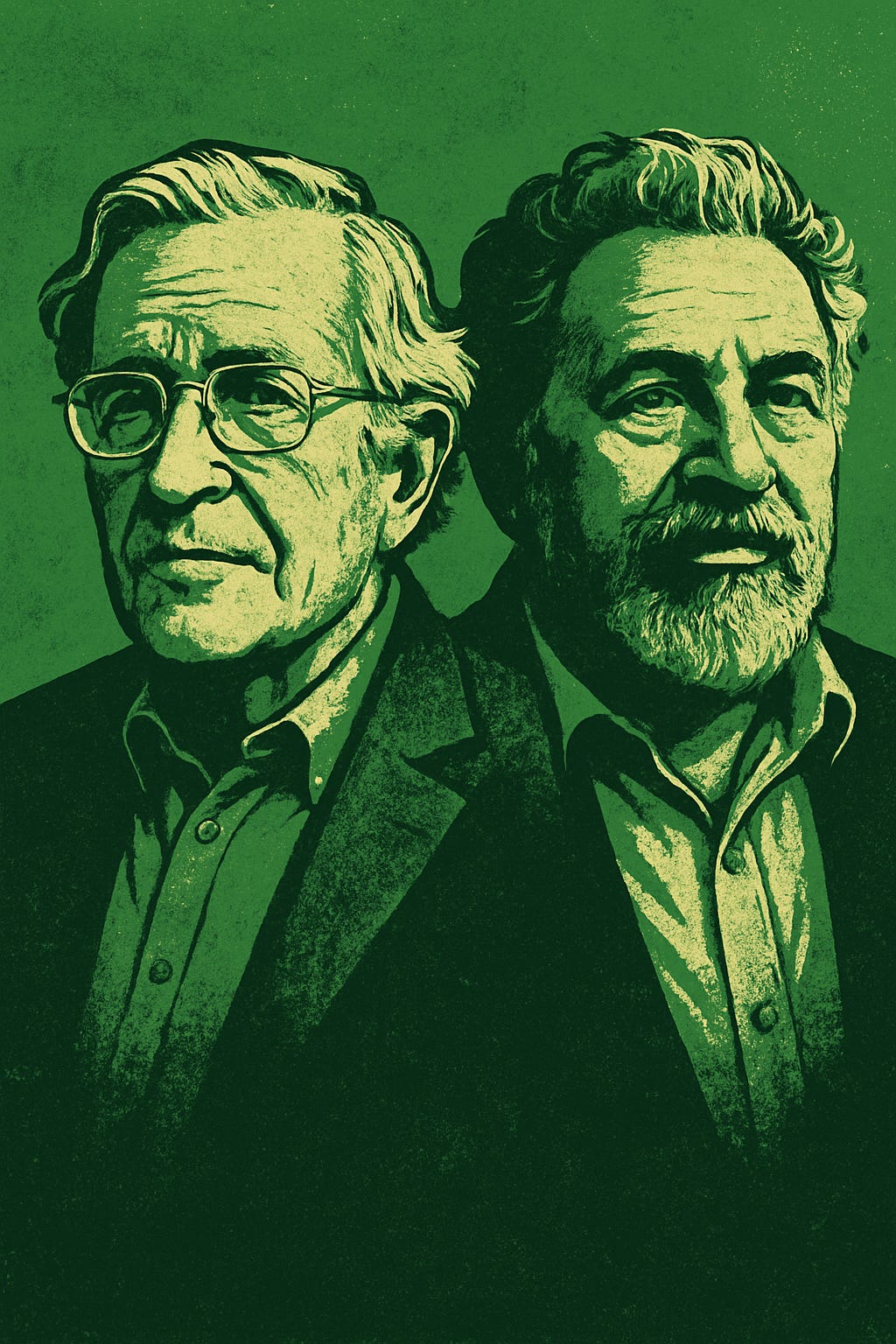The modern Green Party is often misunderstood as simply an "environmentalist" party — a single-issue movement concerned only with climate change or conservation. In truth, the Green Party’s ideological DNA runs far deeper and more radical than that. Its roots lie in libertarian socialism, anarchism, and critiques of authoritarian power that emerged from thinkers like Murray Bookchin and Noam Chomsky, two of the most important influences on the movement’s foundational values.
Bookchin — The Radical Theorist Behind Green Politics
Of the two, Murray Bookchin had the most direct impact on the political philosophy that shaped Green Parties, especially in Europe (Germany, UK) and in the early U.S. Green Party.
A former Marxist who broke with state socialism, Bookchin spent the 1960s and ’70s developing what became known as social ecology, a framework that linked ecological crises to systems of hierarchy and domination in human society.
Bookchin rejected the idea that ecology was just a scientific or technocratic issue. He argued that the root cause of ecological destruction was hierarchical social relations, capitalism, patriarchy, racism, and especially the authoritarian state itself. His proposed solution was libertarian municipalism: bottom-up, directly democratic communities that could federate to replace centralized, oppressive state structures.
Key Green Party values, grassroots democracy, decentralization, ecological wisdom, social justice, and nonviolence can be traced directly to Bookchin’s writings. Early European Greens drew heavily on his work, and he helped spark the left-libertarian, anti-authoritarian wing of Green politics.
Bookchin was also fiercely critical of authoritarian Marxism and of Marxist-Leninist tendencies in left movements. He argued that true ecological politics must be anti-hierarchical, rejecting not only corporate power but also the bureaucratic state power that many Marxist movements sought to capture.
Chomsky The Voice of Libertarian Socialism
Noam Chomsky, one of the world’s most famous anarchists and libertarian socialists, had a more indirect but profound influence on Green Party activists and sympathizers.
Chomsky never joined the Green Party or formally participated in its founding, but his decades-long critique of U.S. imperialism, corporate capitalism, media manipulation, and state authoritarianism deeply shaped the political consciousness of many Greens.
His work reinforced key Green principles: anti-militarism, anti-corporatism, support for grassroots democracy, solidarity with oppressed peoples, and opposition to concentrated state power. Chomsky’s influence helped steer many Greens toward a deeper understanding of how environmental crises are rooted in broader systems of oppression.
Like Bookchin, Chomsky was anti-Marxist in the authoritarian sense. He respected some of Marx’s critique of capitalism but rejected Marxist-Leninist statism, vanguardism, and the notion that seizing the state could liberate society. In Chomsky’s words, a true anarchist would naturally oppose authoritarian Marxism, because anarchism is rooted in the rejection of hierarchy in all forms: economic, political, and social.
Rejecting Authoritarianism — A Core Green Principle
Both Bookchin and Chomsky helped shape a libertarian socialist current within the Green Party that stands against both corporate capitalism and state socialism. This is the current most aligned with the Green Quadrant of the Political Compass: left-libertarian, decentralized, grassroots, radically democratic.
The early Green Party, particularly in Germany, and to a lesser extent in the U.S. was not born from the liberal establishment, nor from authoritarian socialist parties. It arose from movements of anti-authoritarian, bottom-up activists who saw ecological and social justice as inseparable, and who rejected both corporate rule and centralized state control.
As the Green Party evolved, some factions drifted toward moderate liberalism or watered-down electoralism, a move that Bookchin bitterly criticized. He warned that if the Greens lost their radical, anti-authoritarian edge, they would become just another party trapped in the very systems they were meant to challenge.
Conclusion The Lantern’s Light
Today, reclaiming the radical roots of the Green Party means reconnecting with the philosophies of thinkers like Bookchin and Chomsky and with the anarchist, libertarian socialist tradition that fuels genuine ecological and social liberation.
The Lanterns of the Green Quadrant stand firmly in this lineage. They reject false dichotomies between red and blue, state and corporate power. They seek a world of decentralized democracy, ecological harmony, mutual aid, and true freedom, the vision that first gave rise to Green politics before liberalism and authoritarianism tried to dilute it.
As we build the future, we remember: the Green flame was always anarchist at heart and it will be again.




Good article, as far as it goes. But an incomplete history, leaving out most significant and critical founders! The work of Charlene Spretnak, Friel, Cora, Eleanor Lane, and John Rensenbrink or foundational, without which there would not be an existing party today, I suspect. Another source to check out would be Mark Satin. I don’t know if you was ever in the Green party, but I think he’s some unknown whose writings that elucidated what type of political development in society they felt they needed.
ALOHA SAMANTHA: …. hope i find you well …. insightful article; thanx for writing and sharing this perspective …. while in graduate school, for my M.A. in Public Law/Urban Affairs, i wrote two articles in lieu of a thesis, on anarchism: “Anarchism —— In The 60’s” plus “Anarchism’s Chances in the Near Future”. These were twenty years prior to the creation of and my involvement in the Green Party. Opens up and stimulates lots of discussion. Mahalo again …. aloha from Maui …..